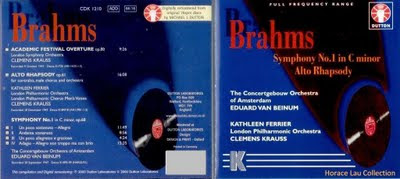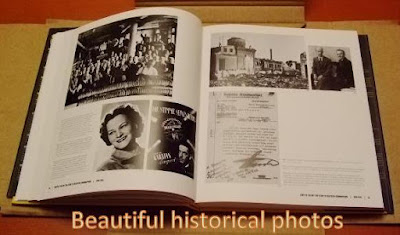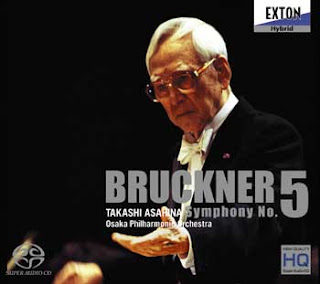Before the brief review of the recorded 1874 version of B4, I'd like to write a few words about the first published edition, and Bruckner's involvement in all the versions and modifications.
The notion that Bruckner is too weak mentally to refuse all the changes suggested to him by his friends or followers is a misconception that has been perpetuated for years. This argument simply doesn't reflect the whole picture.
The fact that he kept the many versions of his manuscripts rather than discarding them speaks volumes for the importance he attached to his own works and the resolution he made to revise his works in pursuit of perfection.
The role played by his well-meaning pupils or followers has been somewhat misunderstood or over-exaggerated. This is particularly true in the case of the first published edition of Symphony No. 4.
I've tried to consider the genesis of Bruckner's symphonies from a modern business viewpoint, and thus the following analogy can be quite useful. A product devised by the R&D department will usually incorporate some input from the marketing department to make it more customer-friendly before it is released to the market. As anyone who has gone through such a process should know, it is very difficult to delineate which modifications are considered unduely influenced by the marketing personnel contrary to the wish of the designer, as cooperative modification is a far more complicated process than a "purist" would like to think or believe.
A practical designer who wants his product to finally see the light of day would listen to the suggestions of the marketing people and modify his product appropriately to make it more attractive, or more "marketable", to the public, particularly if it is deemed "unmarketable" previously by practitioners in the trade. It is not craven submission to persuasion, but open-mindedness to the realities of life.
To complete the analogy, just substitute the appropriate persons into this process. Bruckner is the designer. The products are his symphonies. The marketing people are the Schalk brothers, Levi, etc. The practitioners who say that his product is not marketable are those who decline to perform his symphonies in the first instance. Now you can see that it is just logical that Bruckner needs to modify his symphonies to make them marketable or "playable" by the VPO. And from the manuscripts we all can see that nearly all the modifications were entered by Bruckner himself, that applies to even the Stichvorlage, or the engraver's copy, before the first publication of his scores, especially in the case of Symphony No. 4. The authenticity of this first published score has previously been doubted, but now the "Bruckner problem" has more or less been resolved in this case with the publication of the 1888 version edited by Benjamin Korstvedt published in the Gesamtausgabe recently.
For Bruckner Symphony No. 4, musicologists nowadays have identified and classified up to 7 versions, but for practical purposes, these 7 versions can be considered as stemming from only 3 main versions, or groups of versions depending on one's frame of reference, with major differences. The rest have only minor differences among them. These are the:
- 1874 version
- "1878/1880" version(s): 1878, 1880, 1881, 1886
- 1887 and 1888 versions
The 1874 version was published in an edition by Leopold Nowak (1975), and is relatively uncontroversial. It is the version/edition used in the recordings discussed here.
The "1878/1880" version is so called as it is printed as such on the cover of the Nowak edition of this second version (1953). After the 1874 version was completed, Bruckner revised the first two movements in 1878, and replaced the finale with a new one entitled Volkfest. In December that year Bruckner replaced the original Scherzo with a new one, sometimes called the "Hunt" Scherzo which we are familiar with in the majority of recordings of this symphony, and the "1878 version" (under the umbrella of the group of "1878/1880" versions) was completed.
The Volkfest was to be replaced by another finale one year later. It was published as an appendix to Robert Haa's edition (1936) and later as a solitary moverment in an edition by Nowak (1981). From 19 Nov 1879 till 5 Jun 1880 Bruckner composed yet another new finale, although it shares much of its thematic material with the one in the first (1874) version. This becomes the "1880 version". Although it has not been published in its original form, it was the version used in the premiere of this symphony on 20 Feb 1881, by the Vienna Philharmonic conducted by Hans Richter.
After the premiere, Bruckner made some changes to the symphony in 1881, and it was in this form that Haas published his edition in 1936 -- hence the name "1881 version". This edition has caused some confusion in the past as Haas called it the "original version" (Originalfassung).
Later in 1886, Bruckner prepared a copy of this score for Anton Seidl to bring to New York for a performance there. Again some minor changes were made by Bruckner himself, and Nowak published his edition in 1953 incorporating these changes -- hence the name "1886 version", although as mentioned above, Nowak still called it "1878/1880 version".
So far, even after the first performances, this symphony had not been published, and Bruckner was understandably eager for it to be printed by a publisher. So with the help of others, Bruckner thoroughly revised this symphony in 1887 for its printing by the Vienna publisher Alfred J. Gutmann. The manuscript for this version is the engraver's copy (Stichvorlage) which showed the changes. Here is where lies the long argument as to the authenticity of these changes, i.e. has Bruckner sanctioned these changes? This was the version used in the performance by the Vienna Philharmonic conducted by Hans Richter on 20 Jan 1888. This version is probably of interest to Bruckner scholars only as it is an interim version, not the final thoughts, and this Stichvorlage has been held in a private collection.
After this performance, Bruckner made yet further changes in Feb 1888 in the Stichvorlage and it was the version finally published by Gutmann in Sep 1889. Again the authenticity of this version has been debated since the 1930s, but recently opinion has changed to accept it as the Fassung letzter Hand, i.e. the last manuscript version of the symphony in Bruckner's own hand. Benjamin Korstvedt edited this version in the publication by the Critical Complete Edition (Kritische Gesamtausgabe) in 2004.
----------------------------------------------------------------------------------
For listeners familiar to the commonly used "1878/1880 version", the 1874 version will be an eye-opener in the sense that it is longer, has a completely new Scherzo, and a radically different finale. The thematic and melodic material is largely the same in the two versions in the first movement. For the second movement, there are altered transitional and developmental passages, and the codas are different.
So much for textual differences. Let's see how some of the recordings of this 1874 version go, particularly the new ones by Simone Young and Kent Nagano.
I'd say Young is a very "brave" Brucknerian, never shying away from loud forceful tuttis and climaxes. However, a loud statement in Bruckner does not equate to shouting, but she just sounds brusque. When I compared her performance with Nagano's, I found that her sound picture was only two-dimensional, whereas Nagano could portrait a three-dimensional soundscape with much dynamic and orchestral colour shading. Why two-dimensional? Orchestral transparency is something that sadly eludes Young, and it fact it sounds muddled most of the time. Her positive attribute is the forward momentum that is evident everywhere, and the reading is full of energy and verve. Sometimes it was overdone however. In the opening of the second movement, the upper strings are to play con sordini (with a mute) piano, whereas the cellos will carry the melody mezzo-forte. Young allowed the upper string ostinato, originally as an accompaniment, to become incessant militant steps, which make this nice passage sound like two people talking at the same time rather loudly, and intrusive to say the least.
Nagano's first movement is slower but it just allows time for the themes to unfold. His approach imbues flexibility to his phrasing by using, but not excessively, rubato, and this breathes fresh air into an otherwise rather long-winded version compared with the 1878/1880 one. His meticulous treatment can be seen in this example: the way he moulds the buildup to the climax (10'42 to 11'02) in the Andante.
One major error in Sony's documentation of Nagano's disc is that they wrongly use the movement titles of the second version for this first version (See the picture above). This error occurs not only in the back inlay but also in the CD booklet. This should not have happened in such a release from a major label.
Turning to older competitors, I found Lopez-Cobos' Cincinnati strings too lean and thin. His reading is largely a stop-and-go affair. Dennis Russell Davies has a very slow first movement, but the Andante is too fast. He seems hurried in his phrasing and tends to surge towards the end of a phrase.
Rozhdestvensky's orchestra has distinctive woodwind and horn timbres, which provides a passionate Russian feel. The horns do not manage the legato passages too well, but the pizzicato in the basses is so deep and cavernous. His reading is very romantic, with lingering phrases and sentimental rubato. I'd say he speaks Bruckner's language in a Russian accent, which is quite amusing.
That brings me to my favourite ones for this version. The first recorded effort was made by Eliahu Inbal in Sep 1982 with the RSO Frankfurt. It is a very good and idiomatic reading which can stand the test of time. What an orchestra it is! No wonder Paavo Järvi chose this orchestra to record his Bruckner. Inbal has an excellent rhythmic control, and it is most evident in the dancing rhythms.
Michael Gielen recorded this 1874 version in Apr 1994 with SWF-Sinfonieorchester Baden-Baden. The orchestral sonority is transparent and all sections blend well together. The horns are more stringent however. The best thing is he allows the inner alto and tenor sounds to be heard clearly in a chord among the uppermost and the lowermost ones. One example is the bassoon, where in many other recordings or performances has always been drowned by other instruments, but not so for Gielen. This orchestral balance allows the listener to better appreciate the harmonic and melodic beauty of Bruckner's music. He also knows to present the dominant melodic line in a way for us to follow easily, quite unlike those who just play everything in the instrumentation and get nothing more than an inter-sectional quarrel. He is a master Brucknerian at work here. My heart is with him.
To conclude this long-winded post, Nagano's is a clear winner in these 2 new releases. Young has a task to clean up her orchestral balance and to understand forceful loudness is not sublimity. But at the end of the day, this first version of Bruckner Symphony No. 4 is more a curiosity to me than a lasting joy to return to, compared with the 1878/1880 version which teems with so many wonderful recordings. As far as this version is concerned, Gielen's is the one I'd not part with.


























